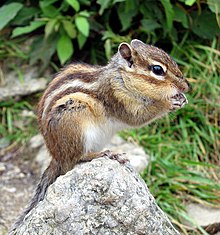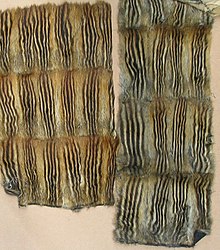Siberian chipmunk
| Siberian chipmunk | |
|---|---|

| |
| Scientific classification | |
| Kingdom: | |
| Phylum: | |
| Class: | |
| Order: | |
| Family: | |
| Genus: | |
| Species: | E. sibiricus
|
| Binomial name | |
| Eutamias sibiricus (Laxmann, 1769)
| |
| Subspecies[2] | |
| |

| |
| Siberian Chipmunk range.[3] | |
| Synonyms | |
|
Tamias sibiricus (Laxmann, 1769) | |
The Siberian chipmunk or common chipmunk (Eutamias sibiricus) appears across northern Asia from central Russia to China, Korea, and Hokkaidō in northern Japan.[4] The Siberian chipmunk was imported from South Korea and introduced in Europe as a pet in the 1960s.[4] It is the only chipmunk found outside North America, and this animal is classed either as the only living member of the genus Eutamias, or as a member of a genus including all chipmunks.
Description

Although these animals can exhibit slight variations in coloration in different geographic regions, they possess several common characteristics.[5] Typically the Siberian chipmunk has 4 white stripes and 5 dark stripes along the back.[4] It is 18–25 cm long, a third of which is the tail.[4] The weight of adults depends on the time of year and food availability.[4] Even though the Siberian chipmunk normally grows to 50–150 grams, this species is relatively small compared to other Sciuridae, such as the Red Squirrel.[4][6] The Siberian chipmunks are not known to exhibit sexual dimorphism, and size and body proportions are the only way to distinguish younger chipmunks from older ones.[5] Their small size may contribute to their relatively short lives, which tend to range from 2 to 5 years in the wild.[4] However, when placed in captivity, as seen in Europe in the 1960s, they have the potential to live anywhere from 6 to 10 years.[4]
Distribution
Siberian chipmunks were found only in their native range of Eastern Asia until the 1960s, when this species was introduced to European countries.[5] During the 1960s, South Korea began to export these animals to Europe as a part of the pet trade.[4][5] Between 1960 and 1980, South Korea exported more than 200,000 individuals to Europe.[5] Human introduction is a major risk for the spread of this species into other forests and areas.[5] By the 1970s, the Siberian chipmunk inhabited suburban forests and urban parks in Belgium, France, Switzerland, Germany, Italy, the Netherlands, and Austria.[4][5] Owners released these animals because they no longer wanted them as pets, or the owners purposefully freed the chipmunks to live naturally in the wild.[5] Other Siberian chipmunks escaped from captivity and inhabited the forested areas of Europe.[5] While thousands of animals were introduced to new environments, their naturally slow spreading, 200 to 250 meters per year, prevented them from rapidly moving to areas beyond Europe.[7]
Habitat

The Siberian chipmunk can survive in a variety of habitats and conditions.[4] They are usually found in coniferous forests, stony areas within forests and mountains, habitats filled with shrub, along waterways or roads, or other small patches of agricultural land.[4][5] In Europe, the introduced populations usually live in deciduous forests, mixed deciduous and coniferous forests, or urban areas with greenery.[4][5] Tamias sibiricus is able to survive in various environmental conditions, anywhere from 29°N to 69°N and -65 °C to 30 °C.[5] However, this species has a low ability of dispersal, and since they are mainly introduced into woody forests or urban areas with greenery, they have less potential to be naturally dispersed to other regions.[5] Also they have trouble overcoming man-made and naturally occurring obstacles, like roads or swamps.[5]
The Siberian chipmunk lives in loose colonies, where every individual has its own territory.[8] The territory ranges from 700 to 4000 m and is larger for females than males and is also larger in autumn than spring.[4] The Siberian chipmunk marks its territory with urine and oral glands inside of its cheeks.[4] This method illustrates one way in which this species communicates with one another.[8]
Behavior
Siberian chipmunks usually live solitary lives, but during the winter they create a burrow, which they often share with another chipmunk.[4][8] Its burrow, which can be 2.5 m long and 1.5 m deep, consists of a nest chamber, several storage chambers and chambers for the waste.[4][8] During this winter season, these chipmunks store 3–4 kg of food in order to survive underground until April or May.[9] In addition to the pairing off during hibernation, they also use a complex voice communication system to interact.[9] They have two vocal sounds, a fast, sharp sound for when they are frightened and a deep croak sound that is thought to be used for mating.[6][9]
Reproduction
While most chipmunks and squirrels are promiscuous in their mating routines, little is known about the mating habits of the Siberian chipmunk.[6] It is known that they are iteroparous, viviparous, and their breeding season usually occurs after hibernation in mid April.[6] They tend to breed only once or twice a year, and the number of offspring varies from 3 to 8.[9] The young are born blind and naked, and they weigh between 3-5 grams.[5] After the 28- to 35-day gestation period, the offspring open their eyes about 20 to 25 days after birth.[4][5] The females are responsible for caring for the young, and they teach them how to forage around 6 weeks.[6] Then the offspring complete the weaning stage around 7 weeks, and they reach the independent stage around 8 weeks.[4][6] Adult body mass is reached at around 3 to 4 months, and by 9 months, both the male and the female reach sexual maturity.[5][9]
Diet
Siberian chipmunks are omnivores that store or cache food.[4][6] Normally, they eat Siberian pine seeds, along with different deciduous and coniferous tree seeds.[4] In addition to seeds, they eat herb roots, insects, mollusks, birds, reptiles, grains, fruit, and fungus.[6]
Ecosystem roles
Siberian chipmunks are essential food sources for other animals, such as diurnal raptors, weasels, and small cats.[6] Other known predators include hawks, owls, and foxes.[7] They evade being preyed upon by these animals by being alert, hiding in their burrows, and using their camouflaged fur to blend in with surroundings.[6] They distribute seeds and fungal spores, and other animals feed off their stored food.[6]

Impacts
Positive impacts
Siberian chipmunks disperse seeds and fungal spores, which help forests grow and regenerate.[6] They also aid species diversity by helping control pests in its environment.[6] In addition to the beneficial aspects for the environment, some humans keep Siberian chipmunks as pets or sell them for their fur or other body parts.[6]
Negative impacts

The increasing rate of urbanization provides humans with greater mobility, and this advancement provides easier opportunities for humans to introduce non-native species, many of which cause health or economic issues.[10] For instance, Siberian chipmunks tend to eat crops and damage urban gardens.[6] In Russia, they eat approximately 50 percent of the forest nuts, and in other locations they can produce economic setbacks in regards to grains and orchards because of large consumption of these products.[7] These chipmunks are also known for preying upon low-nesting birds, and Siberian chipmunks often compete with other small native animals, such as the red squirrel, wood mouse, and bank vole.[7] However the most concerning aspect of this species' influence revolves around its ability to carry diseases, like Lyme disease, that have the potential to create danger for humans and domestic animals.[11]
Lyme disease, also known as Borrelia burgdorferi, is a vector-borne disease that can be transmitted through ticks.[11][12] In comparison to bank voles and wood mice, the Siberian chipmunks contribute a much larger risk when it comes to Lyme disease.[11] The chipmunk's ability to spread this disease poses a risk to humans because Lyme disease can cause neurological, joint, and skin problems.[12] The Invasive Species Compendium states that the Siberian chipmunk can easily survive and spread diseases, like Lyme disease, to humans because the species has high genetic variability and high reproductive potential.[5] Also, with the Siberian chipmunk's movement and introduction into new environments, ticks and other parasites possess a greater opportunity to attach to hosts.[13] Lastly species invasion is difficult and costly to control, so these animals will continue to pose a threat to humans and other animals until they eventually became extinct or until humans actively take measures to reduce their impact on society.[5]
References
- ^ Template:IUCN2008
- ^ Tamias (Eutamias) sibiricus, Mammal Species of the World, 3rd ed.
- ^ IUCN (International Union for Conservation of Nature) 2008. Tamias sibiricus. In: IUCN 2015. The IUCN Red List of Threatened Species. Version 2015.2. http://www.iucnredlist.org. Downloaded on 10 July 2015.
- ^ a b c d e f g h i j k l m n o p q r s t u "Tamias sibericus". Encyclopedia of Life. Retrieved February 27, 2014.
- ^ a b c d e f g h i j k l m n o p q r s compid=5&dsid=62788&loadmodule=datasheet&page=481&site=144 "Invasive Species Compendium". Tamias sibiricus. Commonwealth Agricultural Bureaux. Retrieved 20 February 2014.
{{cite web}}: Check|url=value (help) - ^ a b c d e f g h i j k l m n o Haberland, K. "Tamias sibiricus". Animal Diversity Web. Retrieved 9 April 2014.
- ^ a b c d "Siberian chipmunk, Tamias sibiricus". Great Britain Non-Native Species Secretariat. Retrieved March 4, 2014.
- ^ a b c d MacDonald, David; Priscilla Barret (1993). Mammals of Britain & Europe. Vol. 1. London: HarperCollins. p. 230. ISBN 0-00-219779-0.
- ^ a b c d e Saddington, G (April 3, 2009). "Notes on the Breeding of the Siberian Chipmunk in Captivity". International Zoo Yearbook. 6 (1): 165–166. doi:10.1111/j.1748-1090.1966.tb01736.x. Retrieved 4 March 2014.
- ^ Uspensky, Igor (February 2014). "Tick pests and vectors in European towns: Introduction, persistence, and management". Science Direct. 5 (1): 41–47. doi:10.1016/j.ttbdis.2013.07.011. Retrieved March 25, 2014.
- ^ a b c Marsot, Maud; Chapuis, Jean- Louis; et al. (January 31, 2013). "Introduced Siberian Chipmunks (Tamias sibiricus barberi) Contribute More to Lyme Borreliosis Risk than Native Reservoir Rodents". Public Library of Science. 8: e55377. doi:10.1371/journal.pone.0055377. Retrieved February 10, 2014.
{{cite journal}}: CS1 maint: unflagged free DOI (link) - ^ a b "Diseases and Conditions: Lyme disease". Mayo Clinic. Retrieved March 30, 2014.
- ^ Chapuis, Jean-Louis; Boyer, Réale; Marmet, Pisanu (May 2010). "Personality, space use and tick load in an introduced population of Siberian chipmunks Tamias sibiricus". Journal of Animal Ecology. 79 (3): 538–547. doi:10.1111/j.1365-2656.2010.01659.x. PMID 20202009.

